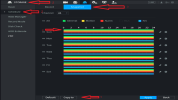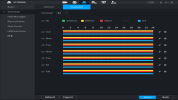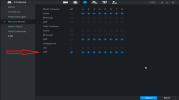Keep in mind many/most of us here do not run H265.
H265 in theory provides more storage as it compresses differently, but part of that compression means it "macro blocks" (technically coding tree units) big areas of the image that it thinks isn't moving. That can be problematic for digital zooming with H265.
However, it also takes more processing power of the already small CPU in the camera and that can be problematic if someone is maxing out the camera in other areas like FPS and then it stutters.
Further some cameras can handle H265 better than others, even if the camera "claims" to support it.
In theory it is supposed to need 30% less storage than H264, but most of us have found it isn't that much. My savings were less than few minutes per day. And to my eye and others that I showed clips to and just said do you like video 1 or video 2 better, everyone thought the H264 provided a better image.
The left image is H264, so all the blocks are the same size corresponding to the resolution of the camera. H265 takes areas that it doesn't think has motion and makes them into bigger blocks and in doing so lessens the resolution in those larger blocks yet increases the camera CPU demand to develop these larger blocks.
In theory H265 is supposed to need half the bitrate because of the macroblocking. But if there is a lot of motion in the image, then it becomes a pixelated mess. The only way to get around that is a higher bitrate. But if you need to run the same bitrate for H265 as you do H264, then the storage savings is essentially zero.
In my testing I have one camera that sees a parked car in front of my house. H265 sees that the car isn't moving, so it macroblocks the whole car and surrounding area. Then the car owner walked up to the car and got in and the motion is missed because of the macroblock being so large. Or if it catches it, because the bitrate is low, it is a pixelated mess during the critical capture point and by the time H265 adjusts to there is now motion, the ideal capture is missed.
In my case, the car is clear and defined in H264, but is blurry and soft edges in H265.
Digital zooming is never really good and not something we recommend, but you stand a better chance of some digital zoom with H264 rather than a large macroblocked H265. I can digital zoom on my overview camera and kinda make out the address number of the house across the street with H264, but not a chance with H265 as it macroblocked his whole house.
H265 is one of those theory things that sounds good, but reality use is much different.
Some people have a field of view or goals that allow H265 to be sufficient for their needs.
As always, YMMV.
Regarding amount of storage, there is this calculator, but that is only part of the equation.
We have built a calculator for you to use and save your results. Click here to use it. To calculate required storage space for cameras, you only need to know two things: The average bit rate, and the amount of time. Then multiply them together with Google, being careful to use the correct...

ipcamtalk.com
While having lots of days/months sounds great, the reality of it is unless it was something catastrophic (which you would have known about sooner anyway), most are not going to start scrubbing video for something that may have happened a few weeks or months ago.
By spending time to dial in the alerts and a frequent peek at what is going on, you would have noticed something around your property within days. I literally every morning in under 30 seconds can scrub what happened the night before and see if anything happened I need to look at further. This is for things off my property. I will know immediately with an alert of a person or car is on my property.
If a neighbor comes up to me and says "sometime around 2 weeks ago someone backed into my car, can you see if you caught it?" You will find that even with the best scrubbing this is a monumental task. Unless they can narrow down the day/time window or you can visually see the damage on your video that you can start looking at the same time everyday until you see the damage and then do an iterative process to narrow down when it was, most of us are not going to scour it.
There are some other considerations or law reasons for businesses that may need longer, but for the average homeowner, the reality that we are going to scrub thru months of video is slim. I would rather have higher quality and 24/7 for a shorter duration than longer duration but lower quality and potentially missed video. But that doesn't mean I run continuous mainstream either. I run substream until triggered and then mainstream. Anything of interest I export out.
Quality is a function of bitrate and resolution. The lower the two, the more storage you can get. But too low and then the quality suffers.
As always YMMV.



